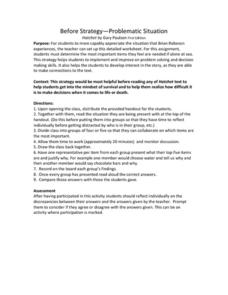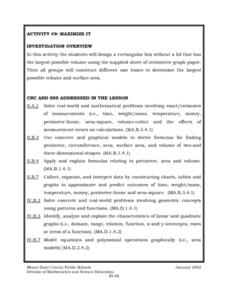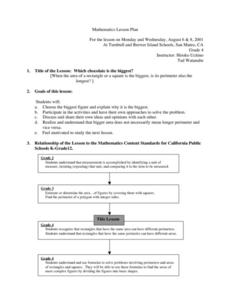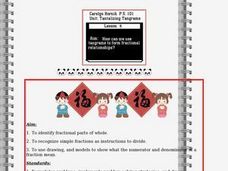Curated OER
Hatchet: Before Strategy- Problematic Situation
If you were stranded on a desert island, what items would be the most important to have with you? Decide whether you'd want a five gallon can of water, a radio, shark repellent, or any other item with an activity designed to prepare kids...
LABScI
Kinematics: The Gravity Lab
Falling objects can be brutal if you don't protect your noodle! Scholars explore the motion of falling objects through measuring short intervals to determine if the distance traveled varies with time. Building off of this, scholars...
Curated OER
Relating Coins to Bills: Enrichment
In this fractions and money worksheet, students use the chart that lists coins, their values, and the fraction they represent in a dollar. Students then use the chart to answer the questions.
Curated OER
Digestion - Part 2
Students read a text on digestion and learn new vocabulary as they read. In this digestion lesson plan, students also complete a picture chart to show the digestive process.
Curated OER
Maximize It!
Pupils design a rectangular box without a lid that has the largest possible volume using the supplied sheet of centimeter graph paper. They work in groups to construct different size boxes to determine the largest possible volume and...
Teacher Created Resources
PEMDAS: Order of Operations
Learners complete algebraic equations. They learn the algebraic order of operations and the acronym, PEMDAS, to help them remember the correct order of operations. Pupils complete algebraic equations using the order of operations.
Curated OER
Which Chocolate Is The Biggest?
Learners investigate the concepts of area and perimeter with the use of chocolate bars. They calculate the perimeter and area of different size rectangle chocolate bars and record the statistics. Then students make a visual comparison...
Curated OER
Triangle Inequality
Students discover that the sum of the lengths of any two sides of a triangle must be greater than the third side. They are shown how a triangle is formed using three strips such as that the triangle is seen inside the strips.
Curated OER
Using Details From The Text
Begin this expository writing activity by reading a non-fiction book of your choice and modeling expository writing. The plan suggests The Trip of a Drip by Vicki Cobb but notes that other texts will work. Learners then choose a...
Curated OER
On the Road Again
Students work with patterns to develop formulas that will help them determine total cost. In this patterning lesson, students watch a video about an NBA trainer. (not included) They work in groups to access the assigned Internet websites...
Curated OER
Volcanic Activity in the U.S.
Students locate and map ten volcanoes in United States, create chart comparing volcanoes by last eruption, type of volcano, location, and interesting fact, and create Powerpoint slide show describing basic
information about volcanoes and...
Curated OER
Coal Mine Industrial Picture Analysis
Students observe coal mine pictures. For this US history lesson, students analyze the pictures realizing that history is shown in pictures and then write a newspaper article about life in a coal town using the pictures as...
Curated OER
Gettysburg Movie
Students create a movie that includes both sound and pictures of the Gettysburg Address using iMovie, digital cameras, and copies of the Gettysburg Address. Extensive examples of student works are given.
Curated OER
Pumped Up Gas Prices
Students spend one month keeping track of the mileage and gasoline amounts they or their family has used. Information is entered into a spreadsheet to help calculate the average gas prices over time.
Curated OER
Subtract Positive and Negative Integers
Review the concept of subtracting positive and negative integers. Learners review the rules for subtracting integers, use manipulatives to visualize the process, and complete an assessment.
Curated OER
Area Model of Multiplication
Fifth graders build area models to represent multi-digit multiplication. This lesson is not complete, but having pupils learn first through hands-on experiences builds a solid mathematical foundation.
Curated OER
Away we Go
Learners work in groups to calculate the costs of a trip to Six Flags amusement park. In this domain and range lesson, students calculate the least and greatest amounts of money needed for tickets, food, souvenirs, and airplane tickets.
Curated OER
Area of Complex Figures
Fifth graders use formulas for calculating areas of squares and rectangles to find area of complex figure, compare their own ideas with their classmates' ideas, and recognize that there are multiple methods for finding area of complex...
Curated OER
Tantalizing Tangrams: Fractional Relationships
Students use tangrams to represent parts of a whole. In this fraction activity, students use tangrams to determine fractional relationships between different pieces. Students use the AppleWorks drawing application to demonstrate the...
Curated OER
Giggle, Giggle, Quack Pizza Fractions
Students explore the concept of multiplication by using pizza. They read an article discussing how math is used everyday. They try to determine how many pizzas they would need to feed the class.
Curated OER
Fraction of a Number
Students explore how to multiply fractions using color tiles. They use the appropriate strategies for the multiplication of fractions. Students use 40 color tiles to practice multiplying fractions. They practice using various fractions...
Curated OER
Cultures Around the World
Students research, using the Internet, cultures of the world. They identify countries, their currency, holidays, climate and societal information. They look at the distance of international cities from their hometown.
Curated OER
Buying My First Car
Students pretend they are about to buy their first new car. They must do all the calculations necessary to estimate the cost of purchasing the car. They see that the math they learn in school really does have real-life applications.
Curated OER
Where Are We Going?
Students practice rounding numbers to ones and tens places, multiplying numbers, and working with simple fractions. They study the placement and distances of planets in the Solar System.























